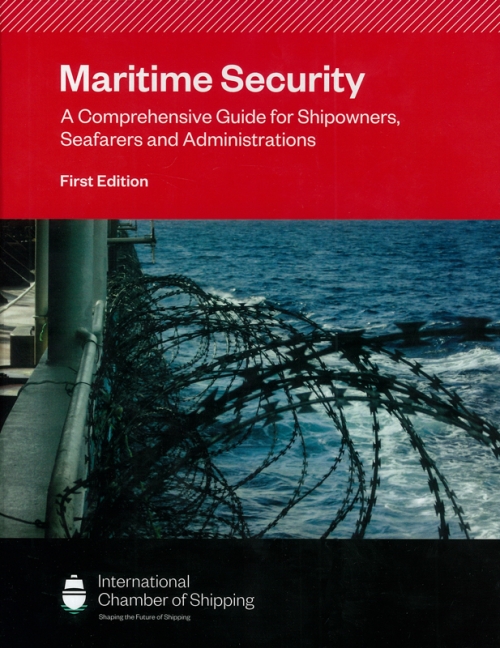Maritime Security: A comprehensive guide for Shipowners, Seafarers and Administrations
Мы не можем гарантировать его наличие и поступление на наш склад по указанной цене
Издание на английском языке
This Guide provides information on the security threats faced by the shipping industry, the statutory requirements that ships, shipping companies and port facilities must meet and guidance on how to conduct a thorough threat assessment for a voyage. Chapter 4 provides a model Ship Security Plan and guidance on how to complete it in accordance with the statutory requirements.
Contents
Foreword
Abbreviations
Chapter 1
Introduction 1
1.1 What is Maritime Security?
1.2 SOLAS and the ISPS Code
1.3 Other Security Threats and Best Practice Guidance
Chapter 2 Maritime Security Threats
2.1 Introduction
2.2 Piracy and Armed Robbery
2.2.1 Gulf of Guinea
2.2.2 Western Indian Ocean
2.2.3 South East Asia
2.3 Terrorism
2.4 War and War-like Risks
2.5 Joint War Committee Listed Areas
2.6 Cyber Risk Management
2.7 Smuggling
2.8 Mixed Mass Migration
2.9 Stowaways
Chapter 3 Overview of Regulatory Requirements
3.1 SOLAS Chapter XI-2 and the ISPS Code
3.1.1 Construction and Carriage Requirements
3.2 Company Requirements
3.2.1 Company Security Officer (CSO)
3.2.2 Ship Security Assessment (SSA)
3.2.3 Training and Pre-Employment Check of Seafarers
3.2.4 On Scene Security Assessment
3.2.5 Ship Visiting a Country that is not Party to the SOLAS Convention
3.3 Shipboard Requirements and Responsibilities
3.3.1 Master’s Discretion for Ship Safety and Security
3.3.2 Ship Security Officer (SSO)
3.3.3 Duties and Responsibilities of the OOW and Security Patrol/Gangway Watch
3.3.4 Drills and Exercises on Ship Security
3.3.5 Ship Security Relationships
3.3.6 Internationally Established Security Levels
3.3.7 Documentary/Information Requirements for Ships
3.3.8 Ship Security Plan (SSP) (see Chapter 4 for further details)
3.3.9 The International Ship Security Certificate (ISSC)
3.3.10 Continuous Synopsis Record (CSR)
3.3.11 Record of Previous Port Calls
3.3.12 Other Information
3.4 Ship Vetting Inspections
3.5 Contracting State Requirements and Responsibilities
3.5.1 Contracting Governments
3.5.2 Recognised Security Organisations
3.6 Port State Responsibilities during Ship/Port Interface
3.6.1 Port State Control
3.6.2 Information that may be Required by Port States
3.6.3 Security Levels at the Port Facility
3.6.4 Declaration of Security
3.6.5 Control Measures that a Port State can Impose on Ships
3.6.6 Port States that Believe a Ship is in Non-compliance with the Requirements of Part A of the ISPS Code
3.6.7 Evidence that Indicates that a Ship does not Comply with the Requirements of the ISPS Code
3.6.8 Checklists of ISPS Related Information that may be Required by Port States
Chapter 4 The Ship Security Plan
4.1 The Ship Security Plan (SSP)
4.1.1 Format and Validity of the SSP
4.1.2 Particulars and Company Details
4.1.3 Master’s Authority
4.2 Ship Security Plan Content
4.2.1 The Three Internationally Adopted Security Levels
4.2.2 Minimum Requirements of the Ship Security Plan
4.2.3 Procedures and Security Measures to be Addressed in the Ship Security Plan Relating to All Security Levels
4.3 Access to the Ship (and Security Levels)
4.3.1 Access Points to the Ship
4.3.2 Personal Identification/Means of Identification Controls
4.3.3 Key Control
4.3.4 Access to the Ship Under the Three Security Levels
4.3.5 Shore Leave Access
4.3.6 Citadel Access
4.4 Restricted Areas on the Ship
4.4.1 Management of Restricted Areas at Each of the Three Security Levels
4.5 Handling of Cargo
4.5.1 Handling of Cargo Measures at the Three Security Levels
4.6 Delivery of Ship’s Stores
4.6.1 Delivery of Ship’s Stores at the Three Security Levels
4.7 Handling Baggage
4.7.1 Handling Unaccompanied Baggage at Each of the Three Security Levels
4.7.2 Handling Accompanied Baggage at the Three Security Levels
4.8 Monitoring the Security of the Ship
4.8.1 Monitoring the Security of the Ship at the Three Security Levels
4.9 Differing Security Levels
4.10 Activities Not Covered by the Code
4.11 Declaration of Security (DoS)
4.12 Audit and Review
4.13 Amendments to the Ship Security Plan
4.14 Inspections
4.15 Security Drills
4.16 Record Keeping
Chapter 5 Managing and Mitigating Security Threats
5.1 Introduction
5.2 Voluntary Reporting and Registration
5.3 Company Threat and Risk Assessment
5.3.1 Threat Assessment
5.3.2 Risk Assessment
5.3.3 Risk Assessment Considerations
5.4 Company Planning
5.5 Ship Master’s Planning
5.6 Ship Protection Measures and Vessel Hardening
5.6.1 General
5.6.2 Vessel Hardening Plan
5.6.3 Watchkeeping and Enhanced Vigilance
5.6.4 Bridge Protection
5.6.5 Access Control
5.6.6 Alarms
5.6.7 Lighting
5.6.8 Safe Muster Points and Citadels
5.6.9 Ship to Ship Transfer (STS) and Static Operations and in Port Security
5.6.10 Drills and Exercises
5.6.11 Routeingand Manoeuvring
5.6.12 Unarmed Security Contractors
5.6.13 Privately Contracted Armed Security Personnel
5.6.14 Vessel Protection Detachments (VPDs)
5.7 Contingency Planning for Developing Security Incidents
5.8 Post Incident Reporting and Investigation
5.9 Humanitarian Considerations
Annexes
Annex A Pre-Arrival Security Clearances
Annex В Arrival in Port and Security/Shore Access for Seafarers
Annex С Useful Resources on Maritime Security
Annex D The Ship Security Assessment (SSA)
Annex E Model Ship Security Plan - Restricted Part
Annex F Model Ship Security Plan - Confidential Part
Annex G Vessel Hardening Plan
Annex H Additional Considerations for Passenger Ship Security



